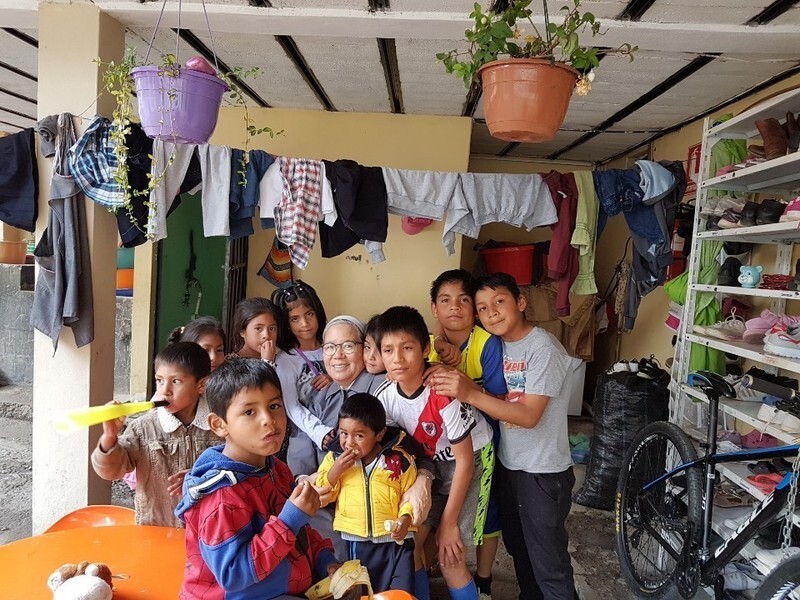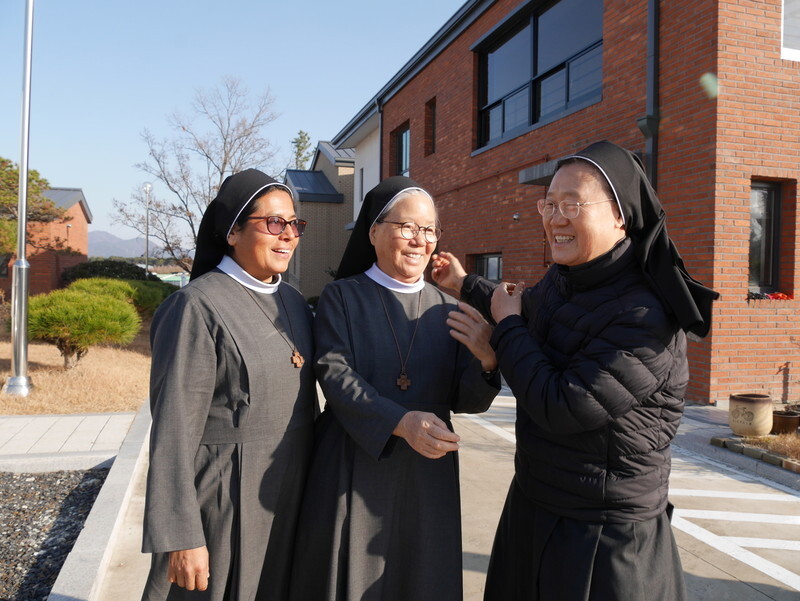Posted on : Dec.30,2019 10:13 KST
 |
|
Sister Veronica with orphans in Ecuador
|
Community of Jesus Christ convent based in Icheon, Gyeonggi Province
 |
|
Sister Veronica with orphans in Ecuador
|
786 Seoljang Road, Janghowon Township, Icheon, Gyeonggi Province. The Community of Jesus Christ is a “very small” order located in the middle of a field. Unlike other convents modeled on medieval European castles, this one is so plain that one would not be surprised to find it was a farmer’s house. The 10 sisters, who had been having their lunch in the refectory, suddenly went into “silent mode” -- perhaps on edge due to the presence of a male in an area typically off limits to men.
Yet within 10 minutes or so, the silence was broken -- as though they were unable to conceal their true nature. Three sisters had arrived at the convent from the order’s headquarters in Ecuador after being away for some years. Founded in Ecuador by Koreans, the Community of Jesus Christ is a unique convent based in Ecuador. Seven of the Korean sisters there had spent the past several days eagerly learning the song “Besame Mucho” in Spanish from Ecuadorian Sister Patricia. But then they learned that the title meant “kiss me a lot.” One of the nuns asked, “How can nuns spend all night singing a song asking someone to ‘kiss me a lot’?” The others burst out laughing. The sisters have devoted themselves to evangelism in Ecuador, a land of martyrs. They scrimped and saved on their living costs in order to support their pastoral efforts there. It seemed strange that they could laugh so freely.
 |
|
Sister Veronica with orphans in Ecuador
|
There was no laughing from even the merriest of nuns when the convent’s abbess, 66-year-old Sister Veronica (Kim Ok), first traveled to Ecuador 35 years ago in 1984. After working as an elementary and middle school biology teacher in South Jeolla Province, she made up her mind to tend to souls in such deprived regions as Seoul’s Nangok neighborhood. But she was truly taken aback to see the situation in Ecuador, which was incomparably harsher than South Korea’s. The dirt road she traveled on her first trip from Guayaquil, Ecuador’s second largest city, to Palmar, where the convent’s dispensary was located, was covered with animal feces; every time a car passed by, trash and dust flew up into a fog that made it difficult to see. Arriving in Palmar, she found drinking water to be in very short supply. Locals brought jugs to the presbytery and begged, “Please let us borrow some water.” They would open the water tank to provide water, which the locals would return in the form of rainwater they collected.
As the effects of El Nino raged through South America one year, there was a sharp rise in waterborne diseases. Children were also giving birth to children; with early marriage the norm, many mothers were still in their teens. But without any midwives to assist them, the mothers were having their children anywhere and everywhere. Seeing this, Sister Veronica made it her first order of business to establish a clinic. The “clinic” was basically a single bed -- but the expecting mothers came in droves. With the help of nuns who had never had children of their own, some 2,582 new lives were brought into the world at the clinic. The fact that not a single of one of those children passed away despite the poor conditions was truly miraculous. But assisting in childbirth was not her only duty. Many homes had children with different fathers and were unable to properly feed and care for them. One mother gave birth to her 14th child, with her 12th having already passed away from parasites and her 13th dead from fever. The chances of the 14th surviving were faint. So Sister Veronica asked her how she felt about giving the child up to neighbors who were the most comfortable financially but had no children of their own. They adopted the child, who eventually grew to become a sterling young person.
 |
|
Sister Veronica (center) with sisters from the Community of Jesus Christ in Icheon, Gyeonggi Province
|
Helping during the AIDS epidemic of Palmar
During the 2000s, AIDS was rampant in Palmar -- a situation exacerbated by the sexual freedom of the beach region. Sister Veronica underwent special training in AIDS patient care and appointed herself a caretaker for the rapidly rising number of people suffering from the disease. Some of the mothers who visited the clinic were also suffering from AIDS. Rumors spread among local residents that the clinic was a “sidoso” -- an AIDS hospital. Sister Veronica made a point of always riding in the same car as the AIDS patients and rubbing their faces when she saw them. “You aren’t infected with AIDS simply by being with AIDS patients,” she explained. In the process, she became a mother figure to the AIDS patients.
Sister Veronica described her 35 years in Ecuador as “one day after another of putting out fires.” But even amid those stresses, she found herself concerned for the future of the young people growing up around her. She formed a group for young people with nowhere to turn for their dreams of a future, raising quail and chickens and operating a factory making bread. At the same time, seeds were drying up as indiscriminate logging of Palmar’s mangroves -- aquatic plants that supply oxygen to the earth -- were reduced from 200 to 38 hectares.
Working with the young people, Sister Veronica launched a campaign to replant mangrove forests. “Once the mangroves are gone, the food chain will be destroyed and the sea itself will be unusable,” she explained. Children who were born at the clinic and went on to join her in her work and campaigning have since gone on to enter the local political community; once recently became deputy mayor. They agreed, however, that Sister Veronica was “Palmar’s real mayor.”
 |
|
Sisters of the Community of Jesus Christ convent in Icheon, Gyeonggi Province, have lunch.
|
Funds to build orphanage urgent
But for every hurdle that she cleared, a new one appeared. As the Ecuadorian economy collapsed, more and more people left their young children with relatives and crossed the border to immigrate illegally. Without remittances from their parents, more and more children were abandoned, leaving them effectively orphaned. Last year, Sister Veronica rented a home in Azogues and began caring for these quasi-orphans. As more and more children began to arrive, she turned for help to her niece Sister Hildegarde (Park Seon-ju, 63), who had spent over two decades caring for orphans in South Korea. Sister Hildegarde began looking after the children, and within a year the number rose from three to 25. With one room of the cramped three-room home dedicated to the sacrament, one for boys, and one for girls, the sisters have no place to stay themselves. Meanwhile, the rental period is approaching its end. With 300 million won (US$255,680), they would be able to build an orphanage -- but that amount is unimaginable for a “micro-convent” that depends on every penny it can get.
While she longs to visit her home country, Sister Veronica has rarely been able to go because of the airfare costs. All she can think about is how many more children the cost of a round-trip ticket would allow her to care for. On Dec. 9, she was finally able to board an airplane home after the South Korean government paid for a round-trip ticket to honor her with the Prime Minister’s Award for overseas service. Every time she visits her home country, it seems like a completely new place with its ongoing development. But Sister Veronica is already in a hurry to head back to the children living in a “different world” on the other side of the planet. In her mind’s eye, she can already see them anxiously looking for the sisters -- singing the words to “Besame Mucho.”
 |
|
Sister Veronica (Kim Ok) with orphaned children in Ecuador. (provided by the Community of Jesus Christ)
|
Telephone: (031)643-4552; donations may be sent via bank transfer to Nonghyup 351-1072-0721-63. Community of Jesus Christ web page: http://cafe.daum.net/Jesucristo.
By Cho Hyun, religion correspondent
Please direct comments or questions to [english@hani.co.kr]













